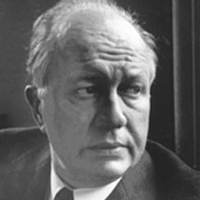The Waking by Theodore Roethke: Summary and Analysis
The Waking is the last poem in the collection of The Waking published in 1953. Roethke received the Prestigious Pulitzer Prize in 1954 for this collection of poetry. The poet is influenced by American Romanticism, especially Whitman's notion of 'eternity of life'. Whitman’s life does not end with death rather continues; forms change, the essence does not change, life continues hereafter in another form.

Theodore Roethke (1908-1963)
This poem is the best example of a villanelle. It is a poem of 19 lines containing 5 tercets aba, 1 quatrain abaa. Villanelle is based on Italian folk dance which is danced in the circle. To develop the circular structure, villanelle makes use of the refrains. The circularity of the form of the poem corresponds with the circularity of life from the individual soul to the cosmic soul and to the individual soul again. As the circular structure of the poem shows the content is also circular. To present this circularity, the poet examines the twofold task of the nature i.e. life and death. Waking and sleeping are metaphor standing for life and death.
It is the nature that gives the life and takes the life. When we are given the life, we should enjoy its pleasures and comforts. The suggestion to take the lively air is the suggestion to enjoy the comforts and pleasures of life. The poet presents life metaphorically as the tree which gets light from the nature. Moreover, life is like a winding stair in which climbs the lowly worm. The lowly worm is the metaphor that stands for the decay in life. When the life decays, we reach to the sleep that comes with metaphor representing death. Nature is the harbinger of both life and death. But, Roethke reminds that the sleep is not the permanent end of human life. Even after we die physically, life continues. Forms change, title change, appearance change, but the essence does not change. The sentence ‘what falls away is always. And is near’ reminds about the continuation of life hereafter.
The title ‘The Waking’ and the opening phrase ‘I wake to sleep’ paradoxically reminds the central idea of the poem that waking is meant for sleeping. When we are awake our fate and destination are unknown. There are many more things that we do not know about ourselves. Despite this incomprehensibility one certain thing is that we are living to die one day, and even after death, life is meant for continuation. This continuity of life has created the circularity of meaning required in the structure of a villanelle. From waking we pass to sleep and from sleep, we come to the waking again. Waking to sleep and sleep to waking is the basic circularity used in the poem. The words ‘waking’ and ‘wake’ symbolically may stand for two possible meanings: first it may stand for the life, second it may stand for the realization that the life continues hereafter.
Related Topics
I Knew a Woman: Summary and Analysis
My Papa's Waltz: Summary and Analysis
Elegy for Jane: Summary and Analysis
 |
bachelorandmaster.com |